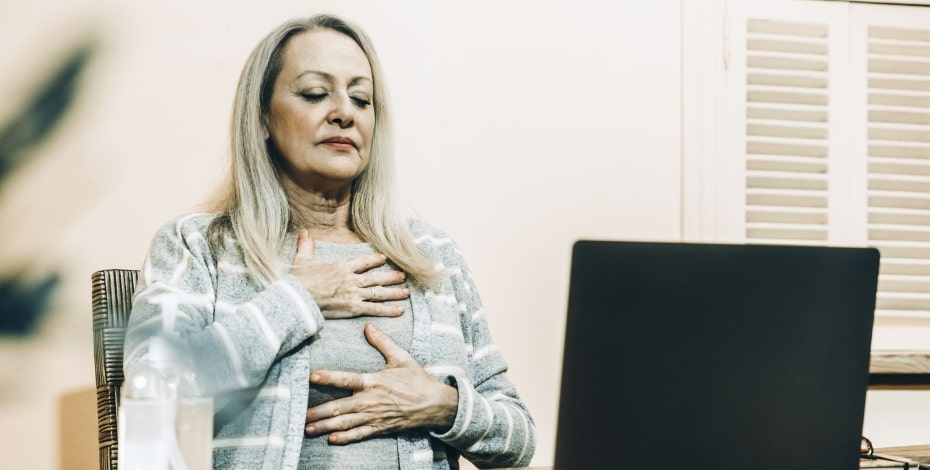
Building a case for repeating pulmonary rehab

Dr Angela Burge is one of 2021’s PRF Seeding Grant recipients, for a project investigating the cost-effectiveness of repeating pulmonary rehabilitation in people with chronic obstructive pulmonary disease. She speaks to us here about the project.
Pulmonary rehabilitation is a well-established intervention for people with chronic obstructive pulmonary disease (COPD), with good evidence for its benefits.
However, the effects of pulmonary rehabilitation programs are not long-lasting and there is limited evidence for the effectiveness of repeating programs.
‘We don’t know the best way to maintain the benefits of pulmonary rehabilitation,’ says Dr Angela Burge APAM, a researcher at Monash University.
‘We know that over one to two years following program completion, those benefits diminish.
'There have been a lot of efforts made to prevent this happening, but no clear method has been identified to date.’
Angela has been awarded a 2021 Seeding Grant from the Physiotherapy Research Foundation for her project ‘REPEAT PR—developing a cost-effectiveness model for repeating pulmonary rehabilitation’, which investigates the development of an economic model for repeating pulmonary rehabilitation for people with COPD.
A clinical physiotherapist and research fellow in the Central Clinical School at Monash University and Alfred Health, she has a broad range of experience in conducting clinical research in rehabilitation and health economics.
Pulmonary rehabilitation is a six-to-eight-week-long exercise and education program with strong evidence for benefits in symptoms, health-related quality of life and functional exercise capacity as well as reduction in hospital admissions.
However, these benefits decline within one to two years following program completion.
While maintenance programs are available, their low-intensity nature is generally not enough to be effective.
‘We want to look at whether repeating pulmonary rehabilitation at regular intervals, or when patients have certain clinical indications, is a better way for people to be managed,’ says Angela.
‘But to do a clinical study to assess this approach would be enormous and take a long time; it’s not really clinically feasible.’
Instead, Angela is developing a health economic model to assess the cost-effectiveness of repeating the rehabilitation program at regular intervals.
With the support of health economists Associate Professor Gang Chen from the Centre for Health Economics at Monash University and Professor Ajay Mahal from the Nossal Institute for Global Health at the University of Melbourne, she hopes to demonstrate that access to a regular program of pulmonary rehabilitation—for example, on an annual or biannual basis—will allow patients to better avoid hospitalisation and to maintain their quality of life.
‘Health economic modelling is actually the perfect way to assess this type of question.

With the PRF's support, Dr Angela Burge is researching repeating pulmonary rehabilitation in people with COPD.
'It draws information from lots of different places about all the different things we know are associated with pulmonary rehabilitation programs and then enables us to generate information about both cost and effectiveness,’ she says.
This is not Angela’s first foray into health economics.
Her PhD project, completed in 2020, compared a home-based program to a traditional outpatient centre-based program, showing that both types of pulmonary rehabilitation program cost about $300 to administer but saved the healthcare system about $10,000 over 12 months after their completion.
Now she is looking at whether completing pulmonary rehabilitation programs at regular intervals after diagnosis is similarly cost-effective.
‘People are diagnosed earlier and they are also living longer.
'The median age of diagnosis is around 60 years now, while life expectancy has extended into the 80s.
'It’s a long time to live with a disease.
'We hope to demonstrate that taking this approach—a series of rehabilitation programs over time—is the best way to manage people’s symptoms and to maintain quality of life,’ Angela says.
Stage one of the study, which was completed earlier this year, comprised a systematic review of the current data on repeating pulmonary rehabilitation, including how often it is repeated and hospitalisation rates of people with COPD, and a multidisciplinary panel discussion by a group of health economists, experts on COPD care and COPD patients with lived experience of completing pulmonary rehabilitation programs.
This information has been used to generate a set of critical model assumptions to form a framework for the model.
The development of the model is now underway and once completed, it will be validated using a real-world dataset.
Angela says the model development and validation will be completed by early next year.
In addition to providing evidence on the best way to manage patients with COPD, the team hopes to produce sufficient evidence to support an application to the Medical Services Advisory Committee for a Medicare Benefits Schedule item number for pulmonary rehabilitation.
‘An MBS item number would enable more clinicians to provide this type of intervention and ultimately enable more people to access these services.
'Currently, the people who access pulmonary rehabilitation programs are just a small minority of those who would benefit from it,’ says Angela.
‘The costs associated with COPD are not just healthcare costs; they’re also the personal costs of people living with COPD and their carers, which are associated with a huge societal burden.’
The PRF acknowledges the legacy of Jill Nosworthy’s support of cardiorespiratory research.
© Copyright 2025 by Australian Physiotherapy Association. All rights reserved.





